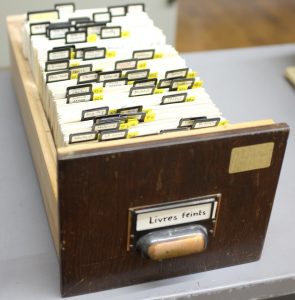
Philippe Cordez takes an interest in book-shaped objects, whose functions may vary. A few examples: mechanical clock, drinking vessel, commode, firearm, gas cigarette lighter, and piggy bank.
Cordez thus adds a chapter to the history of books since the Middle Ages. He does so in line with the work of Kurt Köster, who, as a pioneer on this subject, forged the notion of Verfremdung, since the form counted as much as if not more than the content.
Laurence Bertrand Dorléac
Book-Shaped Objects in Light of Bertold Brecht:
Kurt Köster and Buchverfremdung
Philippe Cordez
Mechanical clock, drinking vessel, commode, camera obscura, firearm, gas cigarette lighter, piggy bank: book-shaped objects may serve the most varied functions. This scarcely studied—though oft practiced—art of combining objects is experienced through usage, as much by the senses as by the mind. It sheds some surprising light on the cultural history of books, from the end of the Middle Ages until today[1].
Kurt Köster and the Catalog of Feigned Books
Yet here the topic will be historiographical and will relate, more precisely, to the notion of Buchverfremdung proposed by Kurt Köster (1912-1986). Köster was the first person to take an interest in objects in the form of books and did so in a remarkably exhaustive way. It is not an accident that Köster was a librarian and bibliographer working in the highest possible post within the German Federal Republic during the years of the Long Boom: from 1951 to 1975, he was head of the Deutsche Bibliothek, first as deputy director and then, beginning in 1959, as director. This institution, which was headquartered in Frankfurt am Main (and which merged after reunification with the Deutsche Bücherei of Leipzig to form the current Deutsche Nationalbibliothek), was in charge of legal deposit of books published in German as well as the ongoing establishment of the German national bibliography.
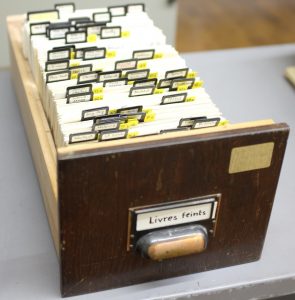
Fig. 1: Kurt Köster, card catalog drawer, Livres feints, Nuremberg, Germanisches Nationalmuseum. Photograph by the author.
Book-shaped objects were not part of Köster’s remit: libraries in principle ignore these books of another kind. It may therefore be deemed that other motivations led him to explore such objects. In order to gauge his undertaking, a visit to the Germanisches Nationalmuseum of Nuremberg is in order. For, there a large room in the reserve collection preserves, among others, Köster’s scholarly bequest to this institution. One of the 24 drawers of a wooden card catalog bearing a label with the mention Livres feints (feigned books) in French contains several hundred catalog cards, most of them handwritten and many of them accompanied by drawings, each one providing a description of an object. Nearly fifty subheading tabs classify these objects by type: “furniture,” “watches,” “scientific instruments,” and so on. Köster’s horizon was broad, and, beyond old objects, he listed “modern packaging” and a few contemporary “artistic ‘book-objects.’” The drawer also contains a few letters. Undoubtedly, book-shaped objects long occupied his attention at the margins of his professional activities.
Buchverfremdung
In comparison to the extent of such activity, Köster published relatively little on this topic. Seven articles nonetheless appeared between 1974, shortly before his retirement, and 1987, just after his death. He formulated his ideas on the matter in an explicit way in 1979, at the start of the most ambitious of these articles, which was published under the title “Bücher, die keine sind. Über Buchverfremdungen, besonders im 16. und 17. Jahrhundert” (Books that are not ones: Apropos of distancings of books, especially in the sixteenth and seventeenth centuries):
I use the notion of distancing to name what will be at issue here, but I do so only with hesitation and for lack of a more adequate concept. This term is indeed almost never employed today except in a very narrow sense used to designate, in the field of the literary studies, an artificial literary figure associated particularly with the name of Bert Brecht.[2]
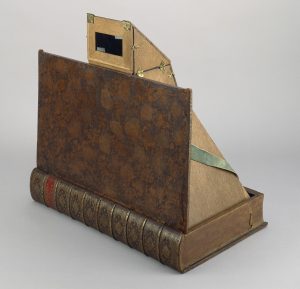
Fig. 2: Camera obscura, Théâtre de l’univers, France, ca. 1750. Los Angeles, Getty Research Institute, Werner Nekes Collection, inventory no. 1379-226. ©Digital image courtesy of the Getty’s Open Content Program.
Köster ultimately retained the concept of Buchverfremdung or “book distancing,” which he nevertheless did not find fully satisfactory. He preferred the French phrase livre feint, found on the label of his drawer, a term he remarked upon in 1977:
Concerning this category of objects, which is interesting as much for cultural history as for bibliology, German unfortunately lacks a term of similar conciseness that is at the same time as eloquent.[3]
Buchverfremdung resists translation. Köster recognized—and seemed to regret—the association of the concept of Verfremdung with the German playwright Bertolt Brecht (1898-1956). The latter employed this term—usually translated, apropos of theater, into English as distancing—in order to designate the effectuation of a critical distance vis-à-vis the performance. Brecht had given it the following definition in a text entitled “On the Experimental Theatre” (1939):
To distance an event or a character is simply to take what to the event or character is obvious, known, evident, and produce surprise and curiosity out of it. . . . The process of distancing, then, is the process of historifying, of presenting events and persons as historical, and therefore as ephemeral.[4]
While Köster stated that he held this to be a “very narrow sense” of the term Verfremdung, he did not himself redefine it in connection with historical or contemporary “distancings” of books or of other objects. Nonetheless, the political pertinence of the Brechtian process could not leave him indifferent. Brecht aimed especially at sharpening people’s awareness in relation to worrying social developments. Fleeing the Nazis, he had left Germany on February 28, 1933. A few weeks later, his books were banned and publicly burned. Stripped of his German nationality in 1935, he remained abroad until 1945.
Books from Exile
In this exile, works were created for which Köster would come to assume a special responsibility. The Deutsche Bibliothek of Frankfurt am Main had been founded in 1946 as a counterpart to the Deutsche Bücherei, which, established in 1912 in Leipzig, was thenceforth in the Soviet zone. Its principal mission was to collect and record works published or manufactured in Germany since May 8, 1945. Added thereto were writings produced outside the country by German-speaking emigres between 1933 and 1945, which until that point had not been made a part of any collection. They occasioned a 1965 exhibition, Exil-Literatur 1933-1945, that was put together “on the basis of this collection, which is certainly numerically modest yet significant on account of its content and held in very high esteem in our institution,” as Köster wrote in his preface to the catalogue.[5] Returning to the idea of distancing or Buchverfremdung, the entry for a work printed in Paris in 1935 is striking:
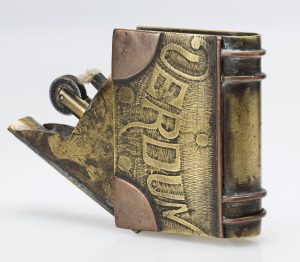
Fig. 3: Gas cigarette lighter, Verdun 1916, France, ca. 1916. Private collection. © Nicolai Kästner.
disguised, illegal, publication. . . . Probably the most interesting of the camouflaged publications of the German emigration movement. Intended to provide an overview of free German literature. With contributions from 41 writers [including Bertolt Brecht].[6]
The title of this collection, Deutsch für Deutsche, or German for Germans, is nationalistic in appearance but may also be read from the standpoint of literary resistance. The cover of this book intended to be circulated clandestinely within the German Reich adopted the appearance of a collection of small educational handbooks printed in Leipzig in the early twentieth century. The terms disguised and camouflaged indicate quite well that this was indeed a “distanced book,” though one of another nature than those in which Köster had taken a personal interest.
Distancing, Reconstructing
Apropos of Brecht, Köster characterized the notion of Verfremdung as a concept coming from “literary studies.” Unlike the playwright, he thus relates the term to the content of the books. While the camouflaged books of exil literature, which “distanced” the appearances of inoffensive printed works, remained an extreme case, Köster goes further as he made clear the nature of his own project: “It will not be a question here of the contents of books, but solely of a usage of the book’s outer form for nonbook ends, as concerns both the function and the content.”[7] This aspect implied that Köster was thenceforth apprehending books in a more radical manner, on the outer edges of their concrete forms, thus sharpening one’s knowledge of their specificity as objects.
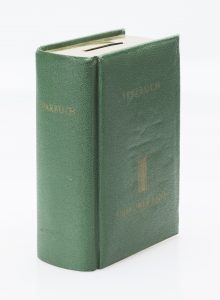
Fig. 4: Piggy bank, Sparbuch. Dresdner Bank. Aktiengesellschaft, German Federal Republic, between 1957 and 1972. Munich, Staatliche Münzsammlung, acquisition no. 2015.77-78. ©Nicolai Kästner.
The notion of Buchverfremdung calls for it to be thought of on the basis of Brechtian “distancing.” If one relates such “distancing” to books and their shapes, one can indeed readily recognize a critical distancing that concerns not only books in general as a genre of objects but also, a fortiori, the library as institution. Köster passed his time during the War as a young soldier, and the primary task incumbent upon his generation was, once the catastrophe was over, to rebuild Germany and its institutions. He took on responsibilities of national import that were heavily symbolic with regard to recent history, and it may be assumed that the study of book-shaped objects appeared to him to relate precisely to those tasks as a healthy act of setting them at a distance.
Book-Shaped Objects
The French expression livres feints defines book-shaped objects in a negative way, as “books that are not books,” ones resting upon an illusion. That postulate has dominated people’s interest in this type of object since Köster’s time.[8] His notion of Buchverfremdung, however, avoided setting up a dualism between reality and representation and instead named a process: there, books appear altered in a direction “alien to” or “at a distance from” their own. In order, however, to describe and to understand this phenomenon in a better fashion, there is reason to privilege henceforth the positive phrase book-shaped objects.
[1] The French version of this text [now translated into English] is a partial translation and adaptation, by Anne-Emmanuelle Fournier and the author, of Cordez 2019. Under the title Fünfzig Objekte in Buchform. Vom Reliquiar zur Laptoptasche, the volume thus introduced presents fifty book-shaped objects, from a reliquary to a laptop carrying case, closely studied by almost fifty authors.
[4] Brecht [1939] 1961, p. 14 (English translation altered). [Translator: This 1961 translation uses “alienate” for Verfremdung, whereas a usual translation is: “distancing.” English Wikipedia http://en.wikipedia.org/wiki/Bertolt_Brecht notes that the Verfremdungseffekt is “translated as ‘defamiliarization effect,’ ‘distancing effect,’ or ‘estrangement effect,’ and often mistranslated as ‘alienation effect.’”
[5] Berthold et al. 1967, p. 5.
[8] See Grünebaum 1988 and Dubansky 2016.
Bibliography
Berthold, Werner, et al. Exil-Literatur 1933-1945. Eine Ausstellung aus Beständen der Deutschen Bibliothek. Exhibition catalog. Revised ed. Frankfurt am Main: Deutschen Bibliothek, 1967.
Brecht, Bertolt. “On the Experimental Theatre.” 1939. Trans. Carl Richard Mueller. The Tulane Drama Review, 6:1 (September 1961): 2-17.
Brückner, Wolfgang. “Kurt Köster und die Pilgerzeichenforschung.” In Hartmut Kühne, Lothar Lambacher, and Konrad Vanja. Eds. Das Zeichen am Hut im Mittelalter. Europäische Reisemarkierungen. Frankfurt am Main: Peter Lang, 2008. Pp. 19-29.
Cordez, Philippe. “Spiel und Ernst der ‚Buchverfremdung’. Kurt Köster, die Deutsche Bibliothek und die Objekte in Buchform.” In Philippe Cordez and Julia Saviello. Ed. Fünfzig Objekte in Buchform. Vom Reliquiar zur Laptoptasche. Emsdetten: Imorde, 2020. Pp. 10-15.
Dubansky, Mindell. Blooks—The Art of Books that Aren’t. Book Objects from the Collection of Mindell Dubansky. New York: Mindell Dubansky, 2016.
Grünebaum, Gabriele. Bücher, die keine sind. Kunst und Kitsch in Buchgestalt. Exhibition catalogue. Dormagen: Wegener, 1988.
Köster, Kurt. “Ein rätselhaftes Buchkuriosum aus der Handbibliothek der Fürstin Pauline zur Lippe (1769-1820). Beiträge zur Kenntnis buchförmiger Pistolenverstecke des 17. und 18. Jahrhunderts.” In Lippische Mitteilungen aus Geschichte und Landeskunde, 46 (1977): 99-107.
_____. “Bücher, die keine sind. Über Buchverfremdungen, besonders im 16. und 17. Jahrhundert.” Buchhandelsgeschichte, 2:4 (1979) 177-202.
Philippe Cordez is deputy director of the German Center for Art History in Paris. He has studied Art History, History, Anthropology, and Museology at the École du Louvre, the École des Hautes Études en Sciences Sociales, and Humboldt-Universität zu Berlin. His dissertation, Trésor, mémoire, merveilles. Les objets des églises au Moyen Âge, was published in 2016. (English translation: Treasure, Memory, Nature. Church Objects in the Middle Ages, forthcoming). Cordez has taught and conducted research in Hamburg, Florence, and Montreal, as well as Munich, where he led a group research project on object studies in art history.
